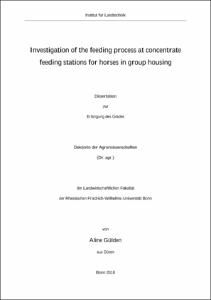Gülden, Aline: Investigation of the feeding process at concentrate feeding stations for horses in group housing. - Bonn, 2018. - Dissertation, Rheinische Friedrich-Wilhelms-Universität Bonn.
Online-Ausgabe in bonndoc: https://nbn-resolving.org/urn:nbn:de:hbz:5n-50486
Online-Ausgabe in bonndoc: https://nbn-resolving.org/urn:nbn:de:hbz:5n-50486
@phdthesis{handle:20.500.11811/7343,
urn: https://nbn-resolving.org/urn:nbn:de:hbz:5n-50486,
author = {{Aline Gülden}},
title = {Investigation of the feeding process at concentrate feeding stations for horses in group housing},
school = {Rheinische Friedrich-Wilhelms-Universität Bonn},
year = 2018,
month = apr,
note = {Computer-controlled concentrate feeding stations are increasingly used to guarantee an individual feed supply of group-housed horses. Blocking times caused by horses remaining in the feeding station without concentrate allowance are classified as a widespread problem in practice. To date, stimulation devices applying an electric impulse seem to be the only reliable means to prevent these blocking times efficiently. However, the scientific community describes the application of an electric impulse to force the horses to leave the feeding station as incompatible with animal welfare considerations.
The aim of the present study was to optimise the feeding process at concentrate feeding stations for horses in group housing. The optimisation primarily focused on the prevention of blocking times caused by horses without concentrate allowance. The studies were conducted at a concentrate feeding station operated at a horse farm under common practice conditions.
The first study examined the effectiveness of an innovative stimulation device in preventing the occurrence of blocking times. For this purpose, an apparatus was developed which applied compressed air between the horses’ hind legs. The behaviour of 16 horses was observed over a period of 3 x 24 h in each of the four trial periods. Initially, the blocking behaviour of the horses could be reduced significantly by the application of compressed air. The increase of the horses’ average daily blocking duration and blocking frequency in the course of the test series indicated the occurrence of a habituation effect over time.
The second study examined if the feeding management implemented at a concentrate feeding station influences the horses’ blocking and activity behaviour. The behaviour of 19 horses was observed over a period of 3 x 24 h in each of the three trial periods (1. 24-hour feeding; 2. Daytime feeding; 3. Three feeding times). The implementation of three feeding times reduced the horses’ blocking frequency as well as the blocking duration significantly. Furthermore, it could be observed that the horses’ activity behaviour was highest with the application of three feeding times. Nevertheless, the adjustment of the feeding frequency did not reliably prevent the occurrence of blocking times.
The present thesis contributes to the development and improvement of concentrate feeding stations for horses in group housing. It has become obvious that the emergence of blocking times is a very complex issue and that the use of concentrate feeding stations goes far beyond the simple utilisation as a feeding device. Against this background, practical recommendations for action as well as further research focuses are pointed out in the present thesis.},
url = {https://hdl.handle.net/20.500.11811/7343}
}
urn: https://nbn-resolving.org/urn:nbn:de:hbz:5n-50486,
author = {{Aline Gülden}},
title = {Investigation of the feeding process at concentrate feeding stations for horses in group housing},
school = {Rheinische Friedrich-Wilhelms-Universität Bonn},
year = 2018,
month = apr,
note = {Computer-controlled concentrate feeding stations are increasingly used to guarantee an individual feed supply of group-housed horses. Blocking times caused by horses remaining in the feeding station without concentrate allowance are classified as a widespread problem in practice. To date, stimulation devices applying an electric impulse seem to be the only reliable means to prevent these blocking times efficiently. However, the scientific community describes the application of an electric impulse to force the horses to leave the feeding station as incompatible with animal welfare considerations.
The aim of the present study was to optimise the feeding process at concentrate feeding stations for horses in group housing. The optimisation primarily focused on the prevention of blocking times caused by horses without concentrate allowance. The studies were conducted at a concentrate feeding station operated at a horse farm under common practice conditions.
The first study examined the effectiveness of an innovative stimulation device in preventing the occurrence of blocking times. For this purpose, an apparatus was developed which applied compressed air between the horses’ hind legs. The behaviour of 16 horses was observed over a period of 3 x 24 h in each of the four trial periods. Initially, the blocking behaviour of the horses could be reduced significantly by the application of compressed air. The increase of the horses’ average daily blocking duration and blocking frequency in the course of the test series indicated the occurrence of a habituation effect over time.
The second study examined if the feeding management implemented at a concentrate feeding station influences the horses’ blocking and activity behaviour. The behaviour of 19 horses was observed over a period of 3 x 24 h in each of the three trial periods (1. 24-hour feeding; 2. Daytime feeding; 3. Three feeding times). The implementation of three feeding times reduced the horses’ blocking frequency as well as the blocking duration significantly. Furthermore, it could be observed that the horses’ activity behaviour was highest with the application of three feeding times. Nevertheless, the adjustment of the feeding frequency did not reliably prevent the occurrence of blocking times.
The present thesis contributes to the development and improvement of concentrate feeding stations for horses in group housing. It has become obvious that the emergence of blocking times is a very complex issue and that the use of concentrate feeding stations goes far beyond the simple utilisation as a feeding device. Against this background, practical recommendations for action as well as further research focuses are pointed out in the present thesis.},
url = {https://hdl.handle.net/20.500.11811/7343}
}






